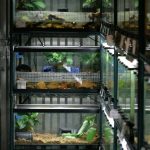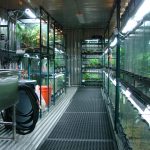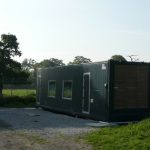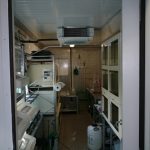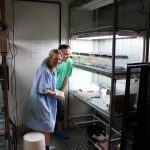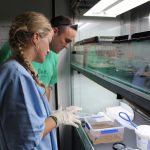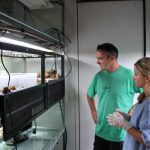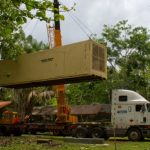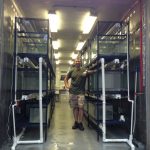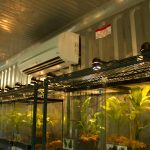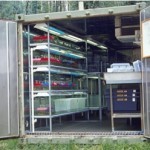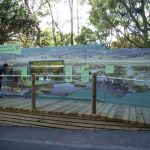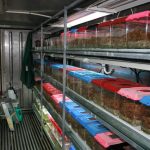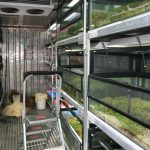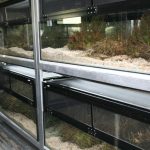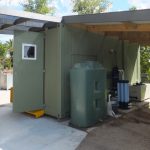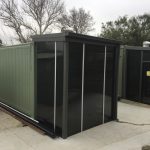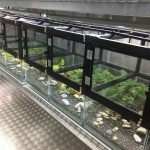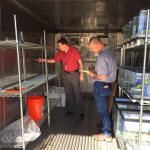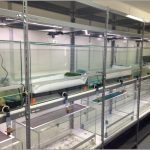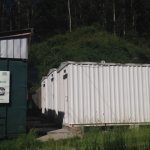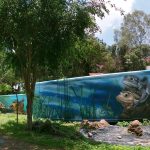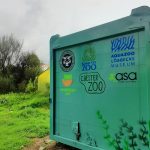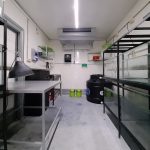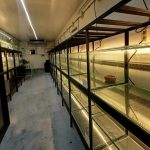Amphibian pods – a practical rescue facility for amphibians
Insulated shipping containers can make ideal rescue facilities (“pods”) for amphibians. They are:
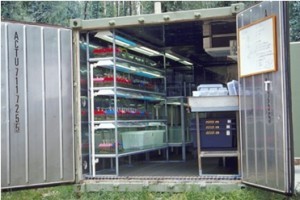 relatively inexpensive, often cheaper than new ‘traditional’ construction (see pricing below)
relatively inexpensive, often cheaper than new ‘traditional’ construction (see pricing below)- available everywhere in the world, often as discounted ‘retired’ units that are still fit for our use
- easily modified to meet particular specifications; every major port in the world seems to have a company that specializes in retro-fitting units for other uses (offices, storage, housing, etc.)
- modular, easily placed adjacent to or on top of each other, and so can be added one at a time to increase capacity at a given facility; ideal where space is limited
- mobile and made to be easily transported, so they can be delivered ‘ready-to-go’ to a point of use, or if need be, relocated from one site to another (try doing that with traditional construction!). All they need is a concrete pad to sit on and hookup to the local water and electric supplies.
- the perfect size to house an entire rescue population of an average-sized amphibian
- easily modified to be an attractive exhibit by adding large viewing windows and graphics
The use of insulated shipping containers for housing amphibians was pioneered by Gerry Marantelli at the Amphibian Research Centre (ARC) in Australia. The ARC has modified containers to order and supplied them to other organizations, including, Tidbinbilla Nature Reserve, Taronga Zoo, Chester Zoo, and Durrell Wildlife Conservation Trust.
There are a number of organizations around the world that are currently using shipping containers for amphibian conservation programs:
- Amphibian Research Centre, Australia
- Atlanta Botanical Garden, USA
- Central Florida Zoo, USA
- Chester Zoo, UK
- Currumbin Sanctuary, Australia
- Durrell Wildlife Conservation Trust, Jersey/Channel Islands
- EVACC (imminent), Panama
- Fundação Parque Zoológico de São Paulo, Brazil
- Honduras Amphibian Rescue and Conservation Center, Honduras
- Macadmaia Castle, Australia
- Centro K’ayra for Research and Conservation of Threatened Amphibians of Bolivia at Museo de Historia Natural Alcide d’Orbigny, Bolivia
- Phoenix Zoo, USA
- Summit Zoo, Panama
- Taronga Zoo, Australia
- Tidbinbilla Nature Reserve, Australia
- Universidad de Concepción, Chile
Below are some example expenses associated with purchasing and fitting out shipping containers:
- ~US$30,000 for used insulated 8’x8’x40’ (320 ft2) shipping container and modifications to significantly improve the infrastructure and electrical service, upgrade air conditioning unit, add durable/waterproof rubber flooring, etc.
- ~USD$10-15,000 for outfitting the container with everything needed for amphibian husbandry (shelves, tanks, lights, filters, mist system), the range allowing for variation in the level of automation and number and size of tanks, complexity of plumbing, etc.
- ~USD$5,000 to ship it internationally (if point of use is different)
- ~USD$2,000 for installation (pad, utility hookup)
- ~USD$500 for portable generator (backup power is vital)
The AArk does not sell or benefit financially from the sale of these containers. We merely propose that they can be practical in many applications, and our partners are available to discuss their experiences (and vendors) with you.
For more information, please contact: Luis Carrillo (Luis@AmphibianArk.org).
Documents for download
Shipping Containers for Frog and Tadpole Husbandry. P. Harlow, M. McFadden & A. Skidmore. Taronga Zoo, Herpetofauna Division, 2007.
Amphibian pod photo gallery
Images courtesy of C. Banks, Camila Castro, R. Gibson, D. Goodall, B. Gratwicke, B. Greaves, K. Johnson, M. McFadden, Tim Steinmetz. (Click images to enlarge)




